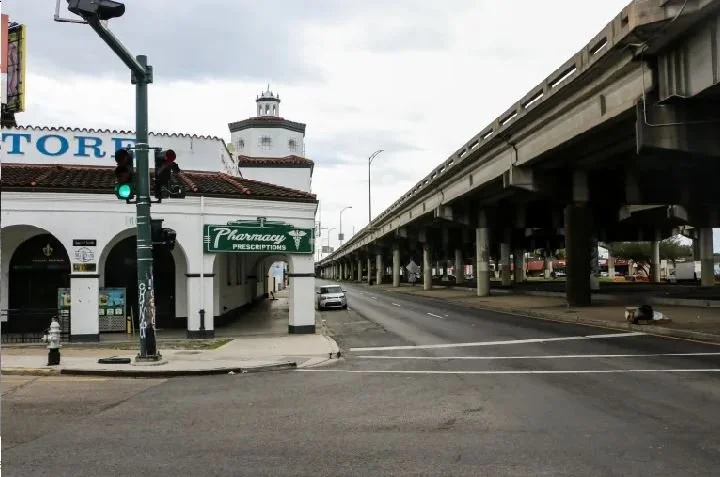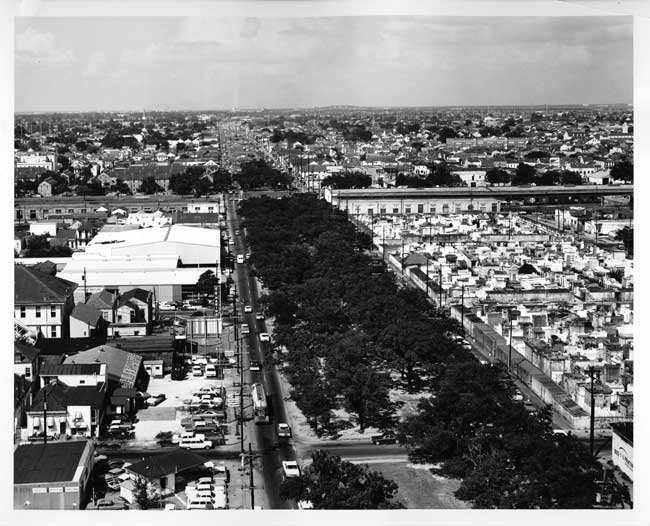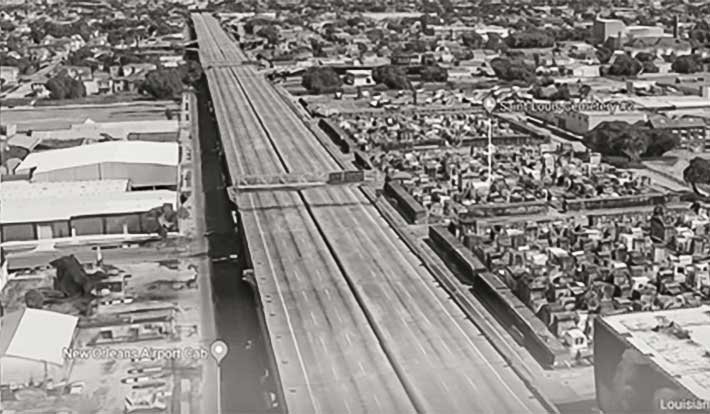Reclaiming Claiborne: Architects, Inequitable Infrastructure, and a Call to Action

The EDR Research Fellowship enables talented individuals to explore fundamental questions around the development of better buildings while embedded in a firm committed to excellence in design and performance. They are challenged to focus on a particular area of inquiry, unconstrained by day-to-day project deliverables, but with the opportunity to interact with and affect the course of ongoing work. All of their research has the distinct power to affect, not only our processes, but the way in which we learn and grow as a firm. We fold everything we learn into our process, with our work providing the feedback loop for future solutions.
The following post takes a closer look into this year’s fellowship focus— Just Change. This topic explores the idea of Designining for Climate & Environmental Justice. Over the course of the fellowship, EskewDumezRipple and our Research Fellow, Aida Ayuk, will continue to create blog posts as updates on the research.
In the bustling city of New Orleans, where jazz once flowed through the streets like a river, the Claiborne Expressway stands as a stark reminder of historical injustice.
This massive, elevated highway, conceived during the era of urban renewal following the Federal Highway Act of 1956, was part of a broader plan that included targeting the French Quarter, a mostly white neighborhood, and Claiborne Avenue. While community advocates successfully blocked the plan for the French Quarter, the Tremé neighborhood, rich in African American culture, was left unaware and unconsulted about the Claiborne project. This lack of engagement with local residents would have profound and enduring consequences for these historic neighborhoods, shaping the narrative of inequitable infrastructure for decades to come.
During the mid-20th century's era of urban renewal, infrastructure projects like the Claiborne Expressway had a profound and lasting impact on communities of color, exacerbating deep-rooted issues of segregation and inequality in American cities. Federal housing policies, enforced by the Federal Housing Administration (FHA) and the Veterans Administration (VA), reinforced racial segregation in housing through practices like redlining and racially restrictive covenants, confining African Americans to segregated neighborhoods. This period coincided with the Civil Rights Movement, marked by the relentless struggle for racial equality.
The original Home Owners' Loan Corporation 'redlining' map of New Orleans'
The Claiborne Expressway remains a lasting symbol of historical injustice, highlighting how past discriminatory decisions still impact lives today, despite progress made during the Civil Rights Movement.
Yet, a new journey has started, driven by resilience and a determination to unearth the untold stories of those affected by these injustices.
This journey, led by local nonprofits such as Claiborne Avenue Alliance, seeks to rectify the consequences of inequitable infrastructure, amplify silenced voices, and forge a more equitable future.
The Setting:
The neighborhoods of Tremé and the Seventh Ward are deeply rooted in the cultural and historical fabric encapsulate the spirit of New Orleans.
Tremé, often considered one of the oldest African American neighborhoods in the United States, is renowned for its vibrant jazz heritage and rich cultural traditions. The Seventh Ward, similarly, steeped in history, has long been home to diverse communities, including Creole, African American, and European immigrant populations.
However, the Claiborne Expressway, marketed as a modern transportation solution, severed these two historic communities in more ways than one. Instead of bridging divides and fostering progress, the highway acted as a physical barrier, cutting through the heart of Tremé and the Seventh Ward. In its wake, the elevated highway and its complex network of off-ramps wrought devastation, leading to the loss of approximately 500 homes and 326 Black-owned businesses, and fundamentally reshaped the landscape of these neighborhoods.
The Circle Food Market — then called the Circle Food Store — before the Claiborne Expressway was built. (Courtesy the Charles L. Franck Studio Collection at the Historic New Orleans Collection, 1979.325.5138)
The Claiborne Expressway seen from outside the Circle Food Market, looking toward the Tremé. (Carly Berlin)
Today, these fractured communities confront environmental challenges linked to the Claiborne Expressway. Recent EPA studies, such as the one managed by Dr. Adrienne Katner, a professor at the LSU School of Public Health, and in collaboration with Amy Stelly's group, Claiborne Avenue Alliance, have and continue to shed light on the heightened health risks residents near major highways like Claiborne face. These studies emphasize the dangers of fine particulate matter (PM2.5) exposure, which can exacerbate respiratory conditions, with African American communities disproportionately affected due to historical patterns of discriminatory urban planning and housing policies. Additionally, the scarcity of accessible green spaces and the constant traffic noise exacerbate the well-being concerns faced by these communities. Our research will collaborate closely with these ongoing studies, sharing community stories and addressing the issue from a design perspective to champion public health and advocate for equitable infrastructure in the heart of New Orleans.
Before: North Claiborne Ave., showing oaks August 29, 1968 (Joseph C. Davi)
After: I-10 completion (Cultural Innovation District)
The Research Question:
Our research centers around a fundamental question:
How do environmental stressors, daily exposure risks, and urban interventions impact residents' well-being, and how can these insights drive change?
Our core objective is to facilitate data-driven solutions prioritizing public health and addressing the challenges of inequitable infrastructure. We aim to uncover community stories, educate on existing environmental stressors, and establish measurable urban intervention metrics, ultimately reshaping the architect's role in advancing equity. Tremé and the Seventh Ward exemplify neighborhoods with histories reflecting broader disparities and shared struggles found in communities nationwide.
The Research Approach:
Our research approach blends quantitative and qualitative elements, by fusing data with personal narratives to illuminate the profound connections between statistics and lived realities. It recognizes the limitations of isolated design practices and underscores the significance of considering communities with diverse demographics and experiences. This methodology serves as more than a research framework; it serves as a reflective mirror for designers. It prompts us to question who truly benefits from our designs, how our assumptions manifest in the physical environment, and how we ensure the well-being of communities impacted by our work from their unique perspectives.
This research functions as a compelling call to action, urging us to genuinely reflect the influence we have on our neighborhoods. While data offers a panoramic view, the community profiles we construct root us firmly in the lived reality we may know little about. Through geographic data, surveys, and the voices of residents, we construct a comprehensive image of the challenges these neighborhoods face.
Amidst the data and figures, it's the voices of community members that resonate most profoundly.
This research aims to share their untold stories, struggles, and aspirations, bridging the divide between data-driven insights and the human narratives that breathe life into our work. It reminds us that our designs should be not only guided by metrics but also shaped by the people who call these neighborhoods home.
What Comes Next:
As our research endeavors take form, we extend an invitation to join us.
Our data is not simply a conclusion but rather a catalyst, one that can drive data-informed interventions, inspire policy recommendations, and empower community-driven change. We recognize the immense value of individuals' stories and organizations' efforts in mediating the impact of environmental stressors.
If you or anyone you know wishes to connect us with individuals eager to share their experiences, nonprofits dedicated to the betterment of these communities, or other organizations actively engaged in mitigating the risks these neighborhoods face, please reach out.
We will be embarking on oral histories with individuals and nonprofits, all while working diligently to devise accessible methods of disseminating information to residents about the developments in their vicinity and the available resources.
Together, we can pave the way for a brighter and more equitable future for these vibrant neighborhoods and their residents.
Connect with Our Research Fellow:
Aida Ayuk
Aida Ayuk, our research fellow for the 2023-2034 year, is joining our firm after completing her Bachelor of Architecture degree from Rensselaer Polytechnic Institute. Aida is charged with exploring this topic as a part of our research fellowship program. Read more about the role of the fellow here.
Have questions or potential connections for Aida’s research pursuit?
Reach out to Aida: aayuk@eskewdumezripple.com.







